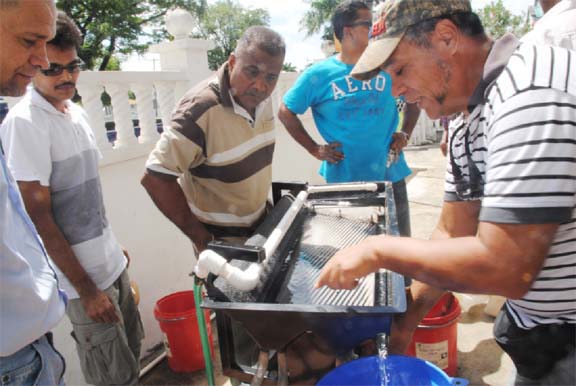Despite President David Granger’s recommitment to the Minamata Convention and eliminating the use of mercury by 2027, the Guyana Gold and Diamond Miners Association (GGDMA) has said it will not support the complete discontinuation of the chemical’s use since it will have significant impacts on the sector and, by extension, economy.
Addressing a High-level Side Event of the 1st Conference of Parties to the Minamata Convention on Mercury in Geneva, Switzerland on September 28, Granger reaffirmed the country’s commitment to the implementation of the Minamata Convention and pointed out that Guyana has set itself the goal of reducing mercury emissions by 55% within the next five years, and a long term goal of completely eliminating the chemical’s use by 2027.
When Stabroek News contacted the GGDMA last Tuesday to ascertain the current extent of the use of mercury in the mining sector, it was related that a statement addressing Granger’s statements at the Convention and the use of mercury would be issued during the week. No statement was issued. However, Stabroek News has obtained the GGDMA’s review of the Draft National Action Plan for the Elimination of Mercury, which was submitted to the Ministry of Natural Resources on September 15 and where it said the end of the legal trade and use of mercury is a concern. The GGDMA said it would support a reduction in the use of mercury and eliminating the mercury released into the atmosphere by adhering to codes of practices and health and safety regulations. But it added that it would not be in support of ending the legal trade of the substance “since it will have significant impacts on the mining sector and the economy.”
The GGDMA further noted that even though significant efforts have been made to reduce mercury use, no better alternative has been demonstrated to replace the widely-used substance. “The draft National Action Plan specifies measures to reduce mercury usage by half in the next five years and projects complete elimination in the next 10 years. The approach for reduction seems logical and practical, however, complete elimination may be a fool’s goal,” it stated, while emphasising that there is no specific method or technology suggested within the Action Plan that can replace mercury use within the artisanal small- and medium-scale gold mining sector.
In 2013, the Correia Mining Company became one of the first local gold mining companies to adopt the use of mercury-free technology to recover gold by using an apparatus called the shaking table.
However, a source in the mining sector explained to Stabroek News that while the shaking table is an option, it is costly and a very large investment for small- and medium-scale miners, who currently dominate the industry.
The source also explained that since mercury is a cheaper alternative, it will always be preferred by the two groups of miners. The source added that the other relevant bodies have also been making strides to ensure that the use of mercury is done in line with safety and health regulations.
In Guyana, mercury is mainly used in the gold mining industry. Granger had pointed at the recent conference that the artisanal, small- and medium-scale gold-mining sector is significant to the national economy and the sector produced over 700,000 ounces of gold or 12.1% of the Gross Domestic Product in 2016, of which 67.7% of total gold production came from more than 3,000 artisanal, small- and medium-scale mining enterprises.
The sector employs more than 18,000 persons directly and supports the livelihoods of more than 100,000 persons indirectly and is the country’s single largest foreign exchange earner.
At the same time, the sector is responsible for 41% of anthropogenic emissions and releases of mercury and, therefore, the reduction of mercury emissions is highly dependent on the reduction in the use of the metal in gold-mining. The mercury used in the amalgamation process in gold-mining has leached into the waterways – rivers and creeks – and poses a threat to the country’s aquatic systems and its biodiversity.





